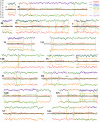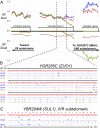Microbe domestication and the identification of the wild genetic stock of lager-brewing yeast
- PMID: 21873232
- PMCID: PMC3167505
- DOI: 10.1073/pnas.1105430108
Microbe domestication and the identification of the wild genetic stock of lager-brewing yeast
Abstract
Domestication of plants and animals promoted humanity's transition from nomadic to sedentary lifestyles, demographic expansion, and the emergence of civilizations. In contrast to the well-documented successes of crop and livestock breeding, processes of microbe domestication remain obscure, despite the importance of microbes to the production of food, beverages, and biofuels. Lager-beer, first brewed in the 15th century, employs an allotetraploid hybrid yeast, Saccharomyces pastorianus (syn. Saccharomyces carlsbergensis), a domesticated species created by the fusion of a Saccharomyces cerevisiae ale-yeast with an unknown cryotolerant Saccharomyces species. We report the isolation of that species and designate it Saccharomyces eubayanus sp. nov. because of its resemblance to Saccharomyces bayanus (a complex hybrid of S. eubayanus, Saccharomyces uvarum, and S. cerevisiae found only in the brewing environment). Individuals from populations of S. eubayanus and its sister species, S. uvarum, exist in apparent sympatry in Nothofagus (Southern beech) forests in Patagonia, but are isolated genetically through intrinsic postzygotic barriers, and ecologically through host-preference. The draft genome sequence of S. eubayanus is 99.5% identical to the non-S. cerevisiae portion of the S. pastorianus genome sequence and suggests specific changes in sugar and sulfite metabolism that were crucial for domestication in the lager-brewing environment. This study shows that combining microbial ecology with comparative genomics facilitates the discovery and preservation of wild genetic stocks of domesticated microbes to trace their history, identify genetic changes, and suggest paths to further industrial improvement.
Conflict of interest statement
The authors declare no conflict of interest.
Figures



References
-
- Bar-Yosef O. The Natufian culture of the Levant, threshold to the origins of agriculture. Evol Anthropol. 1998;6:159–177.
-
- Salamini F, Özkan H, Brandolini A, Schäfer-Pregl R, Martin W. Genetics and geography of wild cereal domestication in the near east. Nat Rev Genet. 2002;3:429–441. - PubMed
-
- Hornesey I. A History of Beer and Brewing. Cambridge, UK: RSC paperbacks; 2003.
-
- Joffe AH, et al. Alcohol and social complexity in ancient western Asia. Curr Anthropol. 1998;39:297–322.
-
- McGovern PE. Uncorking the Past: The Quest for Wine, Beer, and Other Alcoholic Beverages. Berkeley, CA: University of California Press; 2009.
Publication types
MeSH terms
Associated data
- Actions
- Actions
- Actions
- Actions
- Actions
- Actions
- Actions
- Actions
- Actions
- Actions
- Actions
- Actions
- Actions
- Actions
- Actions
- Actions
- Actions
- Actions
- Actions
- Actions
- Actions
- Actions
- Actions
- Actions
- Actions
- Actions
- Actions
- Actions
- Actions
- Actions
- Actions
- Actions
- Actions
- Actions
- Actions
- Actions
- Actions
- Actions
- Actions
- Actions
- Actions
- Actions
- Actions
- Actions
- Actions
- Actions
- Actions
- Actions
- Actions
- Actions
- Actions
- Actions
- Actions
- Actions
- Actions
- Actions
- Actions
- Actions
- Actions
- Actions
- Actions
- Actions
- Actions
- Actions
- Actions
- Actions
- Actions
- Actions
- Actions
- Actions
- Actions
- Actions
- Actions
- Actions
- Actions
- Actions
- Actions
- Actions
- Actions
- Actions
- Actions
- Actions
- Actions
- Actions
- Actions
- Actions
- Actions
- Actions
- Actions
- Actions
- Actions
- Actions
- Actions
- Actions
- Actions
- Actions
- Actions
Grants and funding
LinkOut - more resources
Full Text Sources
Other Literature Sources
Molecular Biology Databases
Miscellaneous

